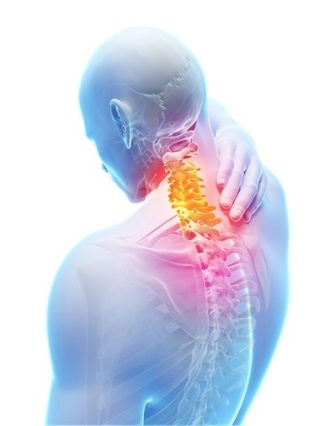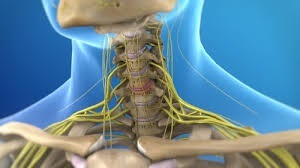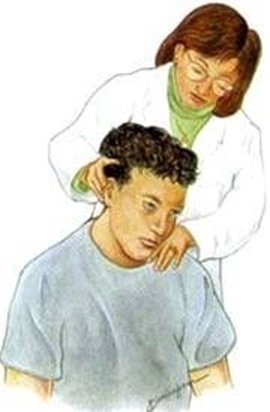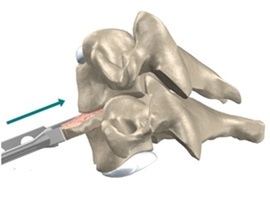A degenerative disease of the discs (osteochondrosis) in the cervical region of the spine is the main cause of the painful symptoms in the neck and radiates to the pain in the hands. Pain manifestations are beginning to show in that case, when one or more of the intervertebral discs in the cervical region of the spine start to collapse due to degeneration.
Predisposition of some people to the development of degenerative disc disease, it is possible, has a genetic component. Trauma can also accelerate, and sometimes cause the development of degenerative changes in the cervical spine.
Treatment of degenerative disc disease of the cervical spine, which gives good results only if he has regular character and is consistent and systematic. Osteochondrosis of the cervical spine is included in the list of the most common reasons symptomatology in patients of working age, who long sits at the computer. Often patients do not pay attention to pain and not to seek treatment , which leads to complications.
Risk factors for degenerative disc disease of the cervical spine

While almost all people sooner or later develop involutional degenerative changes in the cervical spine, there are some factors that may make it more likely to early development of degenerative disc disease or the occurrence of symptomatology. These risk factors may include:
- Genetics. Some studies of twins indicate that genetics plays a greater role than lifestyle in the early development of degenerative disc disease in the cervical region of the spine and the rapid debut of the symptomatology.
- Obesity. Weight is associated with risk of development of degenerative disc disease (degenerative disc disease).
- All the spaces. This habit can hinder the supply of nutrients to the discs and accelerate their hydration.
- In addition, injury to the spine can sometimes start or accelerate the process of degeneration in the cervical region of the spine.
Symptoms
Symptoms of degenerative disc disease of the cervical spine can vary greatly in different people.
When osteochondrosis becomes symptomatic, pain may develop gradually or appear suddenly. Symptoms can vary from a certain discomfort in the neck to exhaustive severe pain with radiating in the arms, numbness and / or muscle weakness.
Main symptoms:
- Pain in the neck. Low-intense pain on a background of stiffness in the neck is the most common symptom is a degenerative disc disease of the cervical spine. However, sometimes the pain can dramatically worsen and last for several hours or days.
- Neuralgia. This type of pain is usually acute or with a sense of defeat shock radiating in the shoulders, arms, hands and / or fingers. As usual, the neuralgia is manifested only on one side of the body.
- Neurological symptoms in the hand, brush and / or fingers. They may report feelings of prickling needles, numbness and / or weakness, which may spread over the entire upper limb. These types of symptoms can interfere with daily activities, such as, for example, print, dress up or hold objects.
- The pain is amplified when driving. In general, the pain caused by degenerative disc, as usual, is amplified when driving and reduces in the game.
- If the pain comes from the so-called degenerative disk, then it is likely that disappears by itself within a few weeks or months. However, other symptoms of degenerative disc disease of the cervical spine often become chronic and require treatment, for example, if the facet joints in the neck also begin to degenerate and / or arises from compression of the nervous root.
Less common symptoms
The more is the cervical spine degenerates, the more likely it is that the spinal canal will narrow and increase the risk of spinal cord compression. In case there is a compression of the spinal cord , then you will develop a myelopathy and symptoms , such as:
- The difficulty of the movement of the hands and / or feet
- Problems with coordination and / or balance
- Loss of control of bowel and / or bladder
- Weakness and / or numbness in any place under the neck
- Shooting pain in the extremities, which can grow when tilted forward
Cervical myelopathy - this is a serious condition that requires immediate medical attention. Typically, this condition occurs in people over 50 years old.
Diagnosis
The diagnosis of degenerative disc disease of the cervical spine can be spotted on the basis of these data are:
- Medical history. First, the doctor needs to examine in detail the symptoms and medical history.
- Physical examination. Then the doctor will perform a physical examination, scanning the neck and control the range of movements of the cervical spine. During the test, patients may be asked to perform certain movements and to inform, increases or reduces the pain in the neck.
- If pain is intense or if they are present neurological symptoms, such as pain, tingling, or weakness in the shoulder, hand or brush, then the doctor will probably prescribe holding of medical imaging .
- Methods of medical imaging (radiography, CT, MRI, PET). If the doctor decides to determine the precise genesis of the symptomatology it is necessary to obtain an image of tissue (disk) then it is likely to be determined by MRI. The MRI examination, radiography, or maybe computed tomography may confirm whether there are signs of degeneration, and also detect another condition (such as osteoarthritis or stenosis), which can cause symptoms.
- After confirming an accurate diagnosis is degenerative disc disease of the cervical spine, as well as all other pertinent conditions, you can understand the Genesis of symptoms and provide effective treatment program.
Conditions associated with osteochondrosis of the cervical spine

Degeneration of the discs are often accompanied by other pathological conditions that develop either in one, or in some cases, one causes the other. The most commonly occur for the following conditions:
- A hernia in the cervical spine occurs in that case, if the degeneration of the disk leads to disruption of the integrity of the fibrous rings and there is ballooning of the content outside of the rings. But a herniated disc can occur after an injury , which ultimately accelerates the deterioration of the disk and leads to the development of degenerative disc disease of the cervical spine .
- Cervical osteoarthritis. Depending on how a disc degenerates and storage space within the spinal column begins to fall, the facet joints may start to move abnormally and cause wear of the cartilage and stimulate the formation of osteophytes in the cervical region of the spine.
- Cervical spinal spine. It is a condition that arises as a result of osteophytes or disc herniation and occurs narrowing of the spinal canal (where it passes through the spinal cord) or foraminal openings (where he held a nervous spine).
But you need to realize that sometimes in some people from birth has narrowing of the spinal canal and the development of symptomatology is not associated with osteochondrosis.
Cervical radiculopathy - symptoms of pain, tingling, numbness and / or weakness, radiating to the shoulder arm and brush may occur when one or more of the nerve roots zaselyalsya or irritated. If stenosis arises spinal cord compression herniated disc or osteophytes, then may develop myelopathy. Possible symptoms are pain, tingling, numbness and / or weakness may be at this level in the area of the neck and in any place below the level of compression. For example, a person may be tingling or weakness in the legs, problems with balance or even having trouble with control of bowel and bladder.
In the presence of symptoms of myelopathy, it is important to timely seek medical help because the condition can proceed, and without treatment can eventually develop paralysis of the limbs and impaired function.
Treatment
As usual, upon the occurrence of the symptomatology resulting from osteochondrosis of the cervical spine are carried out therapeutic actions aimed at the reduction of symptoms. In the first place in the treatment of degenerative disc disease of the cervical spine using non-surgical methods of treatment.

In rare cases, when pain and symptoms persist or worsen, despite several months of treatment, or if there is a risk of damage to the spinal cord, then the question of surgery.
The possibility of conservative treatment
To treat a sore throat caused by osteochondrosis, the doctor usually recommends that one or more of the following treatment options:
- Vacation or lifestyle change. Some actions may be more painful for the neck, for example, pulling the neck forward while working at the computer. Abstinence or change certain activities in the course of a few days or weeks usually reduces the pain. It is also recommended to maintain the correct posture (instead of stoop when sitting or flexion of the neck forward while driving, and so on). Eat healthy food, plenty of hydration, and quitting smoking are also helpful for the health of the disks.
- Treatment of pain with drugs or injections. A certain effect can give OTC analgesics. If the pain is intense, then it can be assigned to a more powerful pain reliever, the drug, such as oral steroids or muscle relaxants, or opiates.
Injections, such as facet injections, nerve or epidural blockade. These may include injections of corticosteroids to a specific structure for relieving local inflammation:
- Caudal epidural injections
- Injections in the facet joints
- Interlaminar caudal epidural steroid injections
- Transforaminal epidural injections
- Selective blockade of nerve roots
- Blockade of the medial branches of the
- Ice and heat can be used in the treatment of degenerative disc disease of the cervical spine.
- Movement therapy. Most of the non-surgical treatment programs degenerative disc disease of the cervical spine will include some of the programs the exercises are isometric, and strength .The choice of exercises should be carried out by a qualified specialist ( doctor, physical therapy) , such as lack of exercise can lead to worsening of the condition . In addition ,exercises should be chosen with regard to the individual characteristics of a particular individual . In general, increasing strength and flexibility in the neck area can reduce the risk of pain and to a certain extent slow down the degenerative changes in the disks.
- Manual therapy. The cervical department of the spine can be adjusted manually by a qualified expert in the field of health care in order to improve the range of motion and / or reduce pain. According to the symptoms in the individual patient it is necessary to conduct physical examinations and / or visualization prior to manual manipulation of the cervical spine.
- Physiotherapy
- Massage
- Acupuncture
- Corethrogyne
Surgical treatment of degenerative disc disease of the cervical spine
The operational methods of treatment of degenerative disc disease of the cervical spine is usually dealt with in two cases:
- Are present neurological symptoms, such as persistent numbness in the hands and / or weakness, or problems with walking or the control of the bowel. If neurological symptoms caused by osteochondrosis of the cervical spine, there is the risk of catastrophic nerve damage, and surgery may be recommended to reduce the pressure on the nerves.
- Chronic pain is serious and is not curable after a period of at least six months of non-surgical treatment, and daily activity becomes challenging. The best surgical outcomes anticipated for patients with chronic pain in combination with other conditions, such as the instability of the motion segments of the cervical and / or radiculopathy.
Basic surgical methods of treatment of degenerative disc disease of the cervical spine are:
- Anterior cervical discectomy and fusion (ACDF).
- The replacement of the artificial disc.
In addition, there are a number of other surgical procedures for the treatment of degenerative disc disease of the cervical spine:

- Endoscopic decompression
- Endoscopic foraminotomy
- Transcutaneous decompression
- Inside the disk use electrothermal therapy
- Selective endoscopic discectomy
- Stimulation of the spinal cord
- Radiofrequency ablation
- Epidural lysis of adhesions
Surgical procedures on the neck, which focus on decompression of the nerve roots and / or spinal cord, and thus a reduction of neurological symptoms, such as pain or weakness in the hands, tends to the good distance results - a positive prediction from 80% to 90% .































